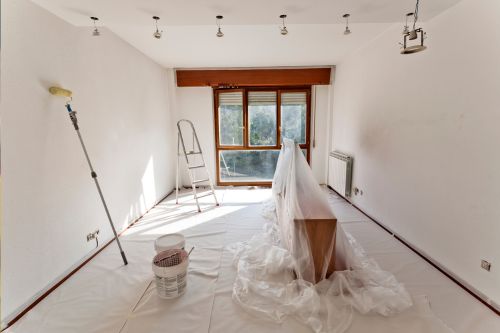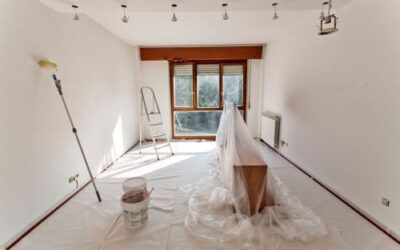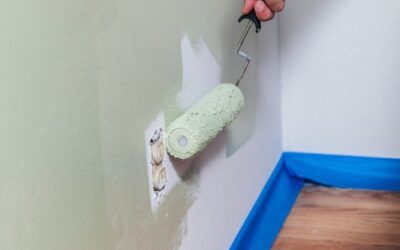Painting a house may seem like a uniform task, but the reality is that the process varies considerably depending on whether the paint is applied indoors or outdoors. Factors such as weather exposure, surface type and preparation determine the final result. Here are the key points that distinguish interior painting from exterior painting and why it is important to consider them.
Surface preparation: Why is it not the same?
Before starting to paint, the condition of the walls should be diagnosed.
-
Interior: Interior walls often only require light sanding, filling cracks or holes, and basic dust or stain removal. The surface is usually more protected from moisture and weathering.
-
Exterior: Here, wear and tear is greater due to rain, sun and temperature changes. It is possible to find deeper cracks, flaking, fungus or moss. Therefore, a cleaning process (power washing or brushing), application of sealants and sometimes masonry repairs are recommended.
Contact our professionals
Climate and ventilation: allies and enemies
When it comes to interior painting, the main concern is adequate ventilation to disperse odours and speed up drying.
-
Interior: Opening windows or using ventilation systems helps to eliminate strong odours and avoids humidity problems. In addition, there are no large temperature variations to compromise the paint.
-
Exterior: In exterior spaces, the weather factor (rain, extreme heat, wind) directly influences the drying time and the quality of the finish. If the forecast indicates rain or very high temperatures, it is advisable to postpone the work in order to obtain an optimum result.
Paint selection: Same brands, different formulas?
Another relevant aspect is the type of paint chosen.
-
Interior: Water-based paints, with matt or satin finishes, tend to be popular because of their low odour, quick clean-up and variety of colours. Stain resistance and washability are sought (especially in kitchens or high traffic areas).
-
Exterior: More resistant paints are required, able to withstand UV rays, humidity and temperature changes. Exterior formulations often include additives that prevent fungal growth and protect the façade from the elements.
Finish and maintenance: what you need to plan for the long term
-
Interior: Over time, it is common for scuffs, stains or wear to appear in specific areas (corridors, staircases, etc.). The advantage is that touching up or repainting an interior wall is easier, as you are less dependent on climatic factors.
-
Exterior: Sun, rain and pollution can deteriorate the colour faster. If a professional job has been done with a quality product and the surface has been properly prepared, the colour and protection tends to last longer. However, you will probably need more frequent repainting than on the interior to maintain the good appearance of the facade.
Costs and labour: how do they differ?
Exterior painting usually requires more man hours due to the cleaning process, preparation and use of equipment (scaffolding, ladders, etc.). In interiors, although care is required with furniture and floors, the scope is more limited.
-
Indoor: Perfect for those looking to do a project in stages (room by room).
-
Exterior: Requires more extensive pre-planning and the hiring of experts who can work at heights and handle weather conditions safely.
What is the best option for your project?
Whether it is more complicated or easier to paint inside or outside the house depends on many factors: the condition of the walls, the climate in your area, the urgency of the project and your budget. However, in both cases, the key is:
-
Have specific paint for interior or exterior use.
-
Prepare the surfaces properly to avoid adhesion problems.
-
Choose the right time: avoid periods of heavy rain for exteriors and, in interiors, plan ventilation so as not to compromise your health or the finish.
-
Hire professionals: an expert will guide you in the choice of materials and techniques, achieving a longer lasting result.
Bartolomé Bas Pinturas: Trust in experience
At Bartolomé Bas Pinturas, we know that each project deserves detailed attention. Our professional team will advise you from the choice of paint to the final touches, whether for more aesthetic and comfortable interior projects, or exterior works that require resistance and durability.
Do you need advice or a customised quote? Contact us and find out how we can bring your spaces to life, inside and out. Make sure you trust specialists who combine technique, quality materials and a passion for detail – your home deserves the best!
Other publications that may interest you
Paint suitable for basements and poorly ventilated rooms
Basements, storerooms or garages have unique conditions: poor ventilation, high humidity and increased risk of mould or condensation. Using conventional paint in these spaces is a common mistake that leads to ephemeral finishes and health problems due to fungi or...
How often should a house be painted depending on its use?
The frequency with which you should paint a house is not always the same. It depends on several factors: the use given to each room, the quality of the paint used, exposure to light or humidity, and even the colour. In this guide we explain how often you should renew...
Tips for painting a room without staining doors and sockets
Painting a room may seem like a simple task, but without the right preparation it's easy to end up with splashes on doors, sockets, switches and even skirting boards. If you want a clean, professional finish, we've got the best tips to avoid stains and save you...




